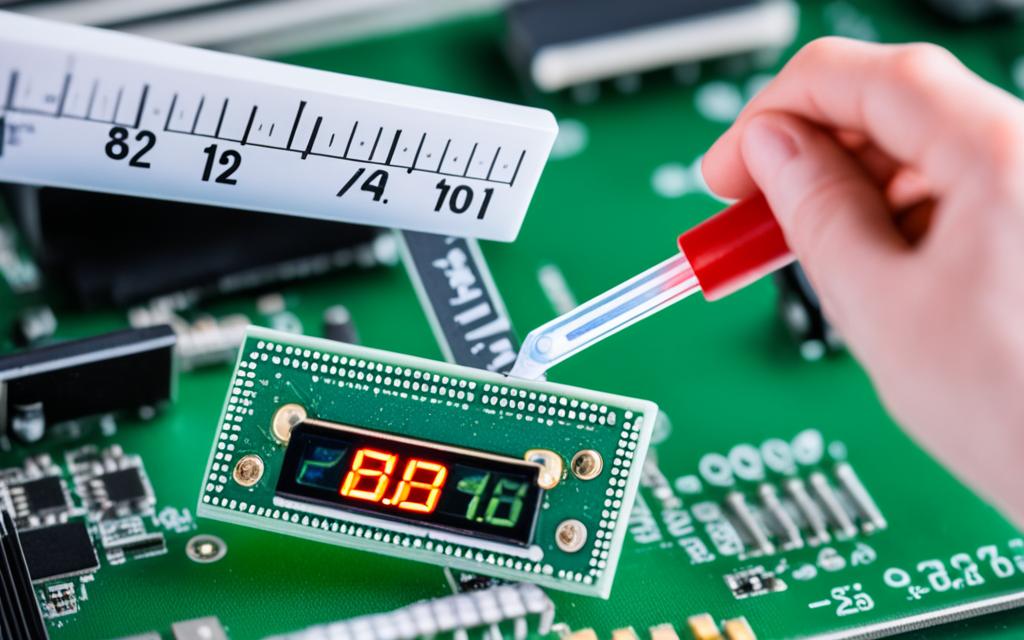Table of Contents
The heart of your computer, the CPU (Central Processing Unit), relies heavily on its temperature. It’s vital to know the safe levels for your CPU’s heat for both its speed and life. Typically, a CPU at rest should stay between 30°C and 50°C.
When you’re running intense programs or gaming, it can safely reach 60°C to 70°C. If it goes above 80°C, however, you might be facing serious problems. Keeping an eye on your CPU’s temperature is thus crucial. For tips on managing your CPU’s heat, check out this helpful guide1.
Key Takeaways
- Normal CPU temperature ranges from 30°C to 50°C when idle.
- Under heavy load, CPU temperature can safely rise to between 60°C and 70°C.
- Monitoring CPU temperature is crucial to avoid overheating and damage.
- Safeguarding your CPU requires proper cooling solutions and regular checks.
- Consistently high temperatures over 80°C can reduce CPU lifespan.
Understanding CPU Temperatures
A CPU’s efficiency and life span greatly rely on temperature control. Knowing why CPU temperatures change is essential for computer enthusiasts. Workload, surrounding heat, and cooling system quality affect these changes. For example, heavy tasks like gaming or video editing can cause significant CPU heat increases.
What Causes CPU Temperature Variations?
Many factors lead to changes in CPU temperature. When a CPU is not busy, its temperature usually stays between 35-50°C (95-122°F). But during demanding activities like gaming2, temperatures can jump to 60-85°C (140-185°F). Older CPUs have a maximum temperature (Tj. Max) of 100°C. Going beyond this limit might harm them permanently2. Dust can also clog the system, affecting how well it cools.
The Importance of Monitoring CPU Temperatures
It’s crucial to keep an eye on CPU temperatures to prevent damage and maintain performance. Overheating can cause your system to crash, damage the CPU, and shorten its life3. Tools like Core Temp or NZXT’s Cam help by providing temperature updates in real-time. This lets users address heat problems quickly. Without such tools, users might not realize their CPU is too hot, risking damage above 90°C3.
Applying better cooling methods, such as faster fans or superior CPU coolers, can help avoid overheating4. These steps help keep the system safe and extend both its performance and hardware life.
What Temp Should My CPU Be At?
It’s crucial to know the right operating temperatures for your CPU. This ensures it performs well and lasts longer. Different activities cause temperatures to change. You must keep an eye on this, especially when doing heavy tasks like gaming.
Safe Temperature Ranges for Different Use Cases
When not doing much or just browsing, your CPU’s temperature should be between 30°C and 40°C (86°F to 104°F). But if you’re gaming or streaming, it can go up to 60°C to 70°C (140°F to 158°F). For top-notch computers, up to 80°C (176°F) is okay as long as you have good cooling. Just make sure it doesn’t get hotter than 90°C (194°F) at peak times to avoid damage5.
Here is a quick guide on temperature ranges for different tasks:
| Usage Scenario | Idle Temperature (°C) | Under Load Temperature (°C) |
|---|---|---|
| Light Tasks | 30-40 | 60-70 |
| Gaming/Streaming | 40-50 | 70-80 |
| Heavy Workloads | 40-65 | 70-90 |
Normal Operating Temperatures Based on CPU Type
Different CPUs have their temperatures. Most are okay between 40°C and 65°C (104°F to 149°F) during regular use. Watch these levels closely when your PC is working hard. It ensures gaming temperatures stay safe, not going over 80°C (176°F) unnecessarily, and staying below 85°C (185°F) for other uses6. Compact Ultrabooks can run at about 75°C (167°F), which is still safe. Always monitor your CPU’s heat to prevent overheating and keep its performance sharp.
How to Check Your CPU Temperature
Knowing how to monitor your CPU’s temperature is crucial. It helps keep your computer healthy and performing well. By keeping an eye on the temperature, you can prevent overheating. There are quite a few methods out there for tracking CPU heat. Each one is suitable for various skill levels and needs.
Using Built-in BIOS Utilities
A simple way to check the CPU temperature is through the BIOS or UEFI. You can enter the BIOS by pressing keys like F2 or DEL when your computer starts. It shows the current temperature. But, it doesn’t update in real-time. Continuous updates are necessary for people who want to monitor their CPU’s performance closely.
Third-party CPU Monitoring Software
For ongoing monitoring, there are many CPU monitoring tools you can use. Applications like Core Temp and HWInfo are great because they provide accurate, real-time temperatures. These tools are helpful especially when your computer is running. They can show the heat levels under different workloads, making it easier to spot overheating quickly. Ideally, your CPU’s temperature should sit around 50°C when it’s not doing much and stay below 80°C during heavy usage7. By keeping track of these temperatures regularly, you can your system’s health.
Using Infrared Thermometers for Accurate Readings
Infrared thermometers are another way to check your CPU’s temperature. They offer fast, no-contact temperature checks. This is especially handy for looking at heat issues in laptops or small systems. Traditional ways of monitoring temperatures might not work well in these cases. Regular temperature checks help prevent the CPU from running too hot. Heat above 95°C can damage your CPU over time89..
| Method | Advantages | Disadvantages |
|---|---|---|
| BIOS/UEFI | Straightforward, built-in to the system | No real-time monitoring |
| Third-party Software | Real-time monitoring, detailed analytics | May require installation and configuration |
| Infrared Thermometer | Quick, contactless readings | Does not provide ongoing data |
Why Is My CPU Temperature High?
Many factors can raise CPU temperatures. Using many demanding applications at once can overwork the CPU, making it very hot. It’s best to keep the temperature below 60°C (140°F) for good performance. But, if it’s over 80°C (176°F), your CPU might be overheating108.
Common Causes of Overheating
Poor cooling and dust build-up are main reasons for high CPU temperatures. Dust blocks airflow, causing the system to heat up10. Cleaning and upgrading your cooling can make a big difference. Overclocking and demanding tasks also make the CPU hotter, sometimes even over 85°C (185°F)6.
Impact of Dust and Poor Ventilation
Dust hurts how well heatsinks and radiators cool the system; it also slows down the computer. You need good airflow to prevent heat build-up10. The placement of your computer is key; if there’s not enough air, cooling won’t work well.
The Effects of Overclocking on CPU Temperatures
Overclocking boosts performance but can overheat the CPU without proper heat control8. You must monitor it closely and maybe need better cooling solutions. Keeping your system clean and changing the thermal paste helps keep temperatures safe6.
FAQ
What Should My CPU Temperature Be At?
Ideally, your CPU should be between 30°C to 40°C (86°F to 104°F) when not doing much. Under heavy use, like gaming, it can reach 60°C to 80°C (140°F to 176°F). It’s vital to keep it in these ranges for long life and good performance.
What Causes CPU Temperature Variations?
CPU temperatures change due to workload, room temperature, and cooling efficiency. Heavy tasks like video editing raise temperatures. Watching these changes helps keep temperatures right.
The Importance of Monitoring CPU Temperatures?
Keeping an eye on your CPU temperature is key to avoid too much heat and damage. Core Temp and NZXT’s Cam show live temps. This way, you can act before it gets too hot, protecting your CPU and making it last longer.
Safe Temperature Ranges for Different Use Cases?
Safe CPU temperatures vary by use. For gaming or high-performance PCs, 50°C to 65°C (122°F to 149°F) is okay. Ultraportables can handle up to 75°C (167°F). Above 85°C (185°F) in intense use needs quick action to avoid damage.
Normal Operating Temperatures Based on CPU Type?
Different CPUs have different normal temps. Usually, they’re cool at 30°C to 40°C (86°F to 104°F) at idle. Under load, they’re around 70°C to 80°C (158°F to 176°F). High-performance CPUs may get a bit hotter but still need close watching.
How to Check Your CPU Temperature?
Using Built-in BIOS Utilities?
BIOS utilities let you check temperature at startup. This is helpful but not for ongoing monitoring. Once you’re in your operating system, monitoring software is better for keeping an eye on temperatures.
Third-party CPU Monitoring Software?
Apps like HWMonitor and NZXT’s Cam are great for watching your CPU’s temperature anytime. They have simple interfaces. They show when temperatures are too high. This helps in keeping your CPU running well.
Using Infrared Thermometers for Accurate Readings?
Infrared thermometers quickly tell your CPU’s surface temperature. They don’t make your CPU work harder. They are perfect for day-to-day temperature checks, helping keep your computer running smoothly.
Common Causes of Overheating?
Causes of overheating include doing a lot at once, poor cooling, or a broken fan. Knowing these helps you spot and fix heating problems early.
Impact of Dust and Poor Ventilation?
Dust can block airflow, making cooling less effective and raising CPU heat. Bad ventilation also increases temperature. It’s important to clean regularly and make sure air moves well in your computer.
The Effects of Overclocking on CPU Temperatures?
Overclocking pushes temperatures up. This can boost performance but needs close temperature watching. Too much heat harms parts. Good cooling is key when overclocking to stay safe.
Source Links
- https://rog-forum.asus.com/t5/overclocking-tweaking/which-is-the-correct-cpu-temperature/td-p/276945 – Which is the correct CPU temperature?
- https://www.techadvisor.com/article/726264/whats-the-best-cpu-temperature.html – What’s the best temperature for your CPU?
- https://community.spiceworks.com/t/what-is-a-normal-temperature-for-a-cpu-and-how-do-i-keep-it-low/948818 – What is a normal temperature for a CPU and how do I keep it low?
- https://www.lenovo.com/us/en/glossary/what-is-cpu-temperature/ – Cpu Temperature: What is CPU Temperature?
- https://www.noyafa.com/blogs/knowledge-base/good-cpu-temperature – What Is A Good CPU Temperature? A Guide to Keep Your Processor Cool
- https://www.avast.com/c-how-to-check-cpu-temperature – How to Check and Monitor Your CPU Temperature
- https://www.tomshardware.com/how-to/how-to-check-cpu-temp-temperature – How to Check Your CPU Temperature
- https://www.pandasecurity.com/en/mediacenter/how-to-check-cpu-temp/ – How to Check Your CPU Temperature – Panda Security
- https://www.avg.com/en/signal/check-cpu-temperature – How to Check and Monitor CPU Temperature on Windows and Mac
- https://www.linkedin.com/advice/1/how-can-you-lower-your-cpu-temperature-too-high – How can you lower your CPU temperature if it is too high or overheating?












